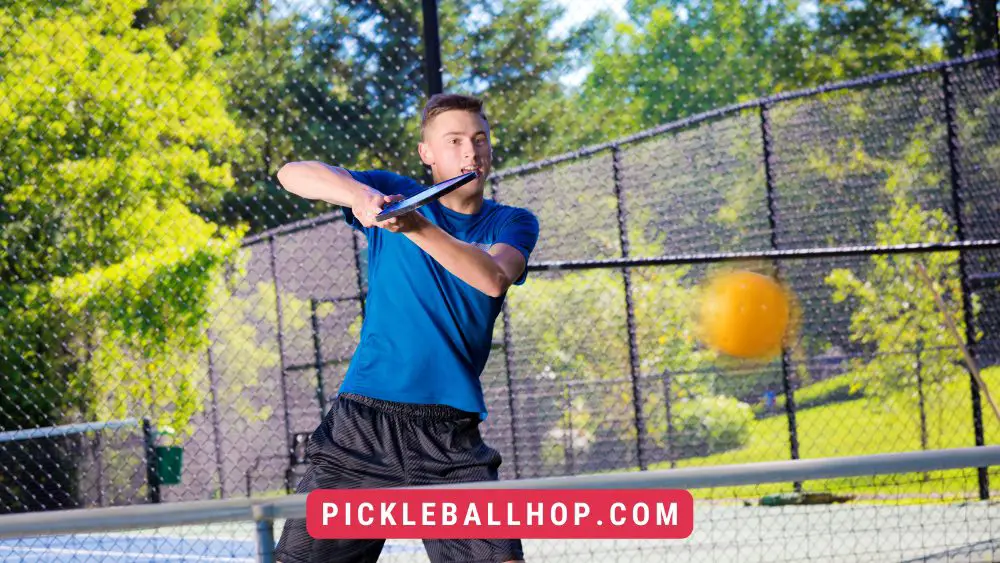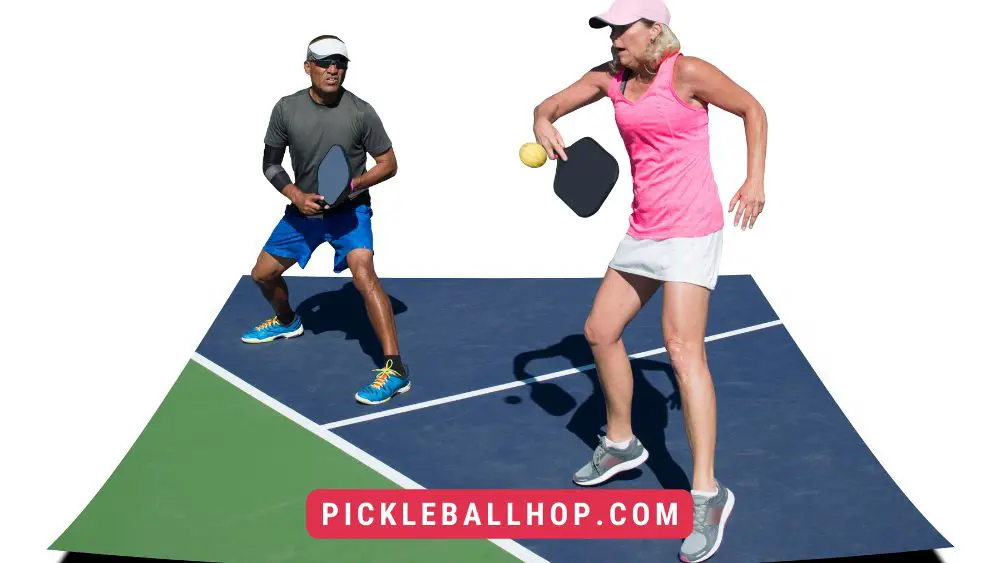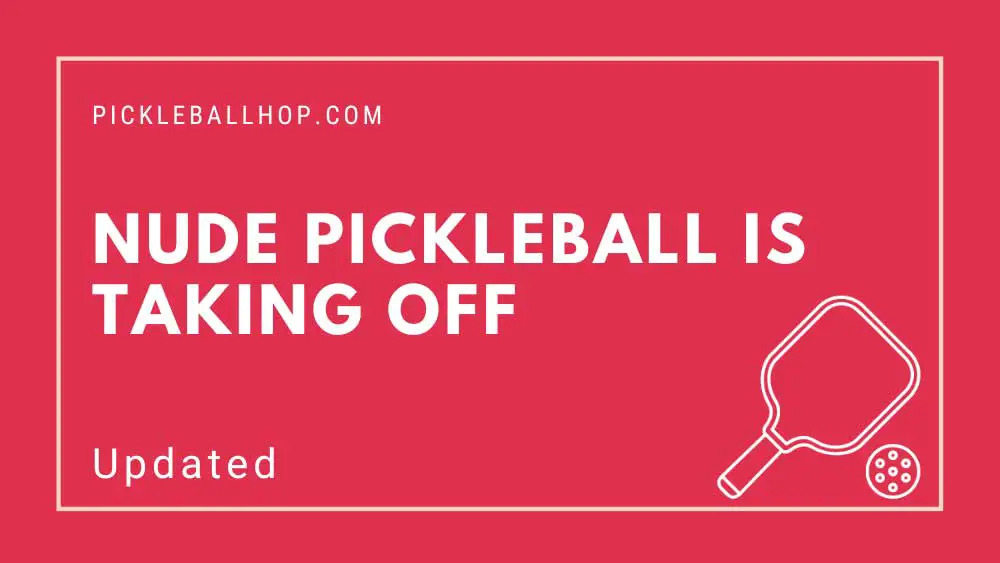When I was first getting into the game, I needed clarity on one aspect: What is a fault in pickleball?
Anything that violates the pickleball rules and stops the game is considered a fault. It is not uncommon to get a fault in pickleball if you hit the ball out of bounds, volley the return of serve, or commit a no-volley zone foot fault.
You may enjoy reading Best Pickleball Paddles
It’s important to learn the rules of pickleball before getting into the game, and learning how to avoid faults can help you become a better player.
With this in-depth guide, I’ll explain What is a fault in pickleball, use some tips to help you avoid them, and show you how to fix all of them.
What Are The 3 Faults In Pickleball?
 Three of the most common pickleball mistakes are:
Three of the most common pickleball mistakes are:
-Playing out of bounds
-Serving before the ball bounces back
-While hitting a volley, step into the no-volley zone
Apart from hitting the ball out, the most common pickleball fault is not letting the return of serve bounce after it is made.
The newer players have a hard time understanding this rule or fault. During the excitement of a game, it is often hard to remember to allow the return of serve to bounce. The return may be instinctively run up and mashed by beginners or those with a tennis background.
In pickleball, this kind of fault gives the serving team the service advantage, while taking it away from the return team.
Pickleball is the only sport that offers this.
For a complete explanation of double bounces, read the guide here.
What Does A Fault Mean In Pickleball?
 In pickleball, a fault involves one of the players hitting the ball out of bounds or into the net, or making a “foot fault” at the baseline line or no-volley zone line.
In pickleball, a fault involves one of the players hitting the ball out of bounds or into the net, or making a “foot fault” at the baseline line or no-volley zone line.
A foot fault at the baseline occurs when the serving player’s foot crosses over the baseline during a serve. It is an error since the serve must be performed behind the baseline.
When a player comes over the non-volley zone line and hits the ball without first letting it bounce, this is referred to as a foot fault.
If you let the ball bounce before hitting it, you can cross the no-volley zone line and hit the ball. On a pickleball court, the only area where ground strokes are allowed is the no-volley zone.
You may enjoy reading Best Elongated Pickleball Paddles
Additional Pickleball Fault-Related Questions
What is a fault in pickleball? If you get a fault, what happens? How do faults affect you? How are faults handled in tennis? My goal is to answer any questions you may have about faults in pickleball.
Despite the fact that playing faults requires some learning, they quickly become second nature.
The game stops if a rule is violated, resulting in a fault. More importantly, you could lose the game or lose a point if you do this!
It is therefore vital to learn about faults and how to avoid them.
Depending on whether you’re on the serving team or the receiving team, receiving a fault means different things, but both need to be remembered.
A fault must be understood in two ways:
- When you commit a fault as a member of the receiving team, it means that the other team receives a point.
- When you commit a fault as a member of the serving team, you forfeit your serving privileges and have your serve given to the other team.
Compared to the receiving team, this may seem like a less serious consequence, but it can leave a lasting impact on a team’s chances of winning. You can earn points only if you serve, so if you lose the serve, you can’t score.
No matter how experienced a player is, there will almost always be faults. Knowing the rules and, more importantly, practicing will help you stay away from them.
You may enjoy reading Best Pickleball Paddles for Beginners
How To Get a Fault in Pickleball
 Pickleball faults are typically attributed to player error, which can be avoided once you get the hang of the sport and have a lot of practice. USA Pickleball Association recognizes these basic faults:
Pickleball faults are typically attributed to player error, which can be avoided once you get the hang of the sport and have a lot of practice. USA Pickleball Association recognizes these basic faults:
- A serve or return that goes into the net.
- Allowing the ball to go out of bounds after hitting it.
- Have the ball bounce twice on your side of the court before you hit it.
- You touch the net while the ball is in play if you or anything is attached to you (e.g., paddle or clothes).
- Before landing on the court, the ball hits a permanent object (such as a tree or light post).
- Specifically, returning a volley or initiating one from a no volley zone is against the kitchen rules.
- The service must be made from the air if it bounces on the court.
- The ball must pass the net before being hit.
- A player or item they are wearing could be struck by the ball. A player’s paddle hand is exempt from this rule if the ball hits them on the wrist or lower part of the hand.
You may enjoy reading What is the non volley zone in pickleball?
Can You Foot Fault In Pickleball?
Pickleball allows two ways for foot faulting. You step over it at the service line when you serve. In the second instance, you step over the no-volley zone line either during a volley shot or after hitting a volley shot but your momentum carries you over it.
To avoid letting the ball bounce, do not step over the kitchen line.
You must always remain behind the line during the volley and even afterward if you’re not letting the ball bounce.
When I’ve had my momentum carry me over the line after I’ve hit the ball, I’ve committed a foot fault by crushing a high volley shot back at my opponent.
Below, I’ll go into more detail about each type of foot fault in pickleball.
No Volley Zone Foot Faults
The pickleball no volley zone also called the kitchen, also has specific faults beyond the basic ones. Among these are:
- During a volley, a player or anything they are wearing or touching crosses the kitchen line.
- In the no volley zone, a player cannot return a volley.
Service Line Faults and Foot Faults
Service faults are faults specific to services, for example:
- An attempt to serve the ball is unsuccessful if the ball is missed.
- During service, the ball may touch any permanent object, such as a wall, fence, light post, or tree.
- The ball should not touch the server’s partner or anything the server is wearing.
- It is called the no-volley zone if the served ball lands in the kitchen.
- The ball will land in the kitchen if it hits the net and lands on the kitchen lines.
- Outside the service area if the ball lands.
- The ball must land outside the court service boundaries if it hits the court.
Service Foot Faults
Lastly, the foot position of the server as he or she prepares to toss and hit the ball is directly responsible for this error. Some examples include:
- Touching the area outside the sideline plane will result in the server’s feet being positioned outside of the plane.
- The server’s feet go outside the centerline plane.
- The server’s feet must not touch any part of the court.
You may enjoy reading Best Cheap Pickleball Paddles
How To Avoid a Fault in Pickleball
It might seem a bit overwhelming to see the above list of all of the rules players must follow in pickleball. You’re still learning the game, so how can you avoid these penalties? If you’re new to pickleball, here are a few tips to help you avoid making mistakes:
- You can avoid getting a fault by simply knowing the rules. You’re likely to earn a few faults if you begin a pickleball game without knowing the rules. As a teammate, do what you can to learn about the game. A rule violation is the number one way for your team to forfeit points.
- It is possible to avoid mistakes if you practice. Practice makes you a much better player, just like it does in most areas of our lives. However, you can’t avoid every fault all of the time. There are many that can be avoided with a little practice.
- Practicing a couple hours a week can help avoid service faults, in particular. With time, your fault rate will decrease.
- Mistakes in the no-volley zone, also referred to as the kitchen, are among the most common. Across the width of the court, this three-and-a-half-foot area lies on either side of the net. It is an automatic fault to return or initiate a volley while standing in this zone. Practicing these types will also help you avoid them.
Some players adhere to the kitchen line as closely as possible without crossing it, which is known as toeing the line.
Having more control over receiving and returning the ball is one of the many advantages of toeing the line. New players, however, should be cautious because it increases the risk of getting a fault.
You will become a much stronger player if you become comfortable near the no-volley zone.
You may enjoy reading Best Rated Pickleball Paddles
Conclusion
The popularity of pickleball is on the rise, and it’s not hard to understand why. Almost anyone can enjoy this exciting and fast-paced game. If you are new to the sport, becoming a great player starts with learning the rules and regulations.
New players often catch on quickly to many ways to get faults in a game, despite the fact that it may seem like there are many ways. Practice in the court after you review the faults. Each day will increase your comfort level and confidence.



